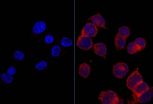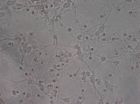(Press-News.org) Results of a study presented today at the World Congress on Osteoporosis, Osteoarthritis and Musculoskeletal Diseases, showed that in boys, higher screen time was adversely associated to bone mineral density (BMD) at all sites even when adjusted for specific lifestyle factors.
The skeleton grows continually from birth to the end of the teenage years, reaching peak bone mass – maximum strength and size– in early adulthood. Along with nutritional factors, physical activity can also greatly impact on this process. There is consequently growing concern regarding the possible adverse effects of sedentary lifestyles in youth on bone health and on obesity.
The Norwegian study explored the hypothesis that greater computer use at weekends is associated with lower BMD. The data was obtained from 463 girls and 484 boys aged 15–18 years in the Tromsø region of Norway. The students participated in the Fit Futures study from 2010–2011 which assessed more than 90% of all first year high school students in the region.
BMD at total hip, femoral neck and total body was measured by DXA (dual-energy X-ray absorptiometry). Lifestyle variables were collected by self-administered questionnaires and interviews, including questions on time per day during weekends spent in front of the television or computer, and time spent on leisure time physical activities. The associations between BMD and screen time were analyzed in a multiple regression model that included adjustment for age, sexual maturation, BMI, leisure time physical activity, smoking, alcohol, cod liver oil and carbonated drink consumption.
Not surprisingly, the researchers found that boys spent more time in front of the computer than girls. As well as high screen time being adversely associated to BMD, in boys screen time was also positively related to higher body mass index (BMI) levels. In contrast to the boys, girls who spent 4–6 hours in front of the computer, had higher BMD than counterparts who spend less than 1.5 hours screen time each day – and this could not be explained by adjustments for the different parameters measured.
Lead author of the study Dr Anne Winther, Arctic University of Norway, Tromsø, stated, "Bone mineral density is a strong predictor of future fracture risk. Our findings for girls are intriguing and definitely merit further exploration in other studies and population groups. The findings for boys on the other hand clearly show that sedentary lifestyle during adolescence can impact on BMD and thus compromise the acquisition of peak bone mass. This can have a negative impact in terms of osteoporosis and fracture risk later in life."
According to the International Osteoporosis Foundation (IOF), approximately one in five men over the age of fifty worldwide will suffer a fracture as a result of osteoporosis. Very low levels of awareness about osteoporosis risk and bone health in males has prompted IOF to focus on osteoporosis in men as a key World Osteoporosis Day theme in 2014.
INFORMATION:
Abstract reference
OC 49 Leisure time computer use and adolescent bone health: findings from the Tromsø study–Fit Futures. A. Winther, E. Dennison, O. A. Nilsen, R. Jorde, G. Grimnes, A. S. Furberg, L. A. Ahmed, N. Emaus. Osteoporos Int. Vol 25, Suppl. 2, 2014
Abstracts from the IOF-ESCEO World Congress on Osteoporosis, Osteoarthritis and Musculoskeletal Diseases: http://www.wco-iof-esceo.org
About IOF
The International Osteoporosis Foundation (IOF) is the world's largest nongovernmental organization dedicated to the prevention, diagnosis and treatment of osteoporosis and related musculoskeletal diseases. IOF members, including committees of scientific researchers, leading companies, as well as more than 200 patient, medical and research societies, work together to make bone, joint and muscle health a worldwide heath care priority. http://www.iofbonehealth.org ; http://www.facebook.com/iofbonehealth ; http://twitter.com/iofbonehealth #OsteoCongress
Media contact
Charanjit K. Jagait, PhD
Communications Director, International Osteoporosis Foundation
Tel.: +41 22 994 01 02
Mob.: +41 79 874 52 08
Email: cjagait@iofbonehealth.org
Does too much time at the computer lead to lower bone mineral density in adolescents?
Study of Norwegian students finds great variation in impact on bone mineral density in boys and girls
2014-04-04
ELSE PRESS RELEASES FROM THIS DATE:
Antioxidants can protect against omega 6 damage -- or promote it
2014-04-04
SAN DIEGO — Given omega 6 fatty acid's reputation for promoting cancer — at least in animal studies — researchers are examining the role that antioxidants play in blocking the harmful effects of this culprit, found in many cooking oils. After all, antioxidants are supposed to prevent DNA damage. But employing antioxidants could backfire, say researchers at Georgetown Lombardi Comprehensive Cancer Center.
In their study, being reported at the AACR Annual Meeting 2015, researchers found that vitamin E actually increased specific damage linked to omega 6 fatty acids. The ...
Light-activated neurons from stem cells restore function to paralyzed muscles
2014-04-04
A new way to artificially control muscles using light, with the potential to restore function to muscles paralysed by conditions such as motor neuron disease and spinal cord injury, has been developed by scientists at UCL and King's College London.
The technique involves transplanting specially-designed motor neurons created from stem cells into injured nerve branches. These motor neurons are designed to react to pulses of blue light, allowing scientists to fine-tune muscle control by adjusting the intensity, duration and frequency of the light pulses.
In the study, ...
UN climate report: Pricing of CO2 emissions critical
2014-04-04
Despite climate change, most polluters still pay little or nothing when they release carbon dioxide into the atmosphere.
'A cost USD 0.15 per kilo CO2 would be enough to solve the whole climate change problem,' says Thomas Sterner, professor of environmental economics at the University of Gothenburg. Sterner is the only Swedish researcher to serve as a coordinating lead author of a new report that the Intergovernmental Panel on Climate Change will present next week.
The third part of Intergovernmental Panel on Climate Change's fifth assessment report, Working Group ...
Flipping the switch on scleroderma
2014-04-04
Scleroderma is a rare and often fatal disease, causing the thickening of tissue, that currently lacks a cure and any effective treatments. A group of researchers, including a Michigan State University professor, is looking to change that.
"Our findings provide a new approach to developing better treatment options where few have existed," said Richard Neubig, chairperson of the Department of Pharmacology and Toxicology in MSU's College of Osteopathic Medicine.
Neubig, along with several of his colleagues from the University of Michigan, have identified the core signaling ...
NASA sees Tropical Depression 05W's bulk west of center
2014-04-04
NASA-NOAA's Suomi NPP satellite passed over Tropical Depression 05W on April 4 at 07:09 UTC/3:09 a.m. EDT. The VIIRS instrument captured a visible picture of the storm, revealing most of the clouds and thunderstorms were west of the center.
The Joint Typhoon Warning Center or JTWC noted that animated multispectral satellite imagery today, April 3, showed that the low-level circulation center is well-defined and that there is fragmented convective banding of thunderstorms wrapping from the north into the southwest, so most of the strongest convection and thunderstorms ...
Researchers probe the next generation of 2-D materials
2014-04-04
As the properties and applications of graphene continue to be explored in laboratories all over the world, a growing number of researchers are looking beyond the one-atom-thick layer of carbon for alternative materials that exhibit similarly captivating properties.
One of these materials is molybdenum disulfide (MoS2), which is part of a wider group of materials known as transition metal dichalcogenides, and has been put forward by a group of researchers in the US as a potential building block for the next generation of low-cost electrical devices.
Due to its impressive ...
Discovery of a mechanism that makes tumor cells sugar addicted
2014-04-04
For almost a hundred years ago is known that cancer cells feel a special appetite for a type of sugar called glucose. The tumor uses this molecule is like the gasoline which depends a sports car to burn faster and grows and multiplies rapidly. It is a little cash process from the energy point of view but allows a superaccelerated cancer cell division. It is what is known as the Warburg effect, which was described in 1927.
Until now little was known about how healthy cells that have a balanced energy consumption depend on this "fast food" calorie in the tumor cell. Today, ...
Vascular changes caused by deep brain stimulation using brain MRI
2014-04-04
Deep brain stimulation has been widely used to treat patients with movement disorders and increasing attention has been paid to its use in the treatment of neurological and psychiatric disorders. However, the influence of subthalamic nucleus or pallidal deep brain stimulation on cerebral vasculature is poorly understood. Even though the metabolic changes caused by deep brain stimulation are being studied using positron emission tomography, the structural changes in cerebral areas like the intracerebral vasculature have not yet been evaluated. Dr. Byeong Sam Choi and colleagues ...
Clinical value of ginsenoside Rb1 against neuronal damage following cerebral ischemia
2014-04-04
Activated microglia-mediated inflammation promotes neuronal damage under cerebral hypoxic-ischemic conditions, so it is likely that inhibiting hypoxia-induced activation of microglia will alleviate neuronal damage. To test this hypothesis, Dr. Lining Ke and co-workers from Southern Medical University and Fujian Medical University in China co-cultured ginsenoside Rb1, an active component of ginseng, and cortical neurons. Their findings indicate that ginsenoside Rb1 attenuates damage to cerebral cortex neurons by downregulation of nitric oxide, superoxide, and tumor necrosis ...
Depression increases heart failure risk by 40 percent
2014-04-04
Stavanger, Norway – 4 April 2014: Moderate to severe depression increases the risk of heart failure by 40%, a study of nearly 63 000 Norwegians has shown. The findings were presented for the first time today at EuroHeartCare 2014.
EuroHeartCare is the official annual meeting of the Council on Cardiovascular Nursing and Allied Professions (CCNAP) of the European Society of Cardiology (ESC). This year's meeting is organised jointly with the Norwegian Society of Cardiovascular Nurses and is held 4-5 April in Stavanger, Norway.
Ms Lise Tuset Gustad, first author of the ...
LAST 30 PRESS RELEASES:
Tracing the quick synthesis of an industrially important catalyst
New software sheds light on cancer’s hidden genetic networks
UT Health San Antonio awarded $3 million in CPRIT grants to bolster cancer research and prevention efforts in South Texas
Third symposium spotlights global challenge of new contaminants in China’s fight against pollution
From straw to soil harmony: International team reveals how biochar supercharges carbon-smart farming
Myeloma: How AI is redrawing the map of cancer care
Manhattan E. Charurat, Ph.D., MHS invested as the Homer and Martha Gudelsky Distinguished Professor in Medicine at the University of Maryland School of Medicine
Insilico Medicine’s Pharma.AI Q4 Winter Launch Recap: Revolutionizing drug discovery with cutting-edge AI innovations, accelerating the path to pharmaceutical superintelligence
Nanoplastics have diet-dependent impacts on digestive system health
Brain neuron death occurs throughout life and increases with age, a natural human protein drug may halt neuron death in Alzheimer’s disease
SPIE and CLP announce the recipients of the 2025 Advanced Photonics Young Innovator Award
Lessons from the Caldor Fire’s Christmas Valley ‘Miracle’
Ant societies rose by trading individual protection for collective power
Research reveals how ancient viral DNA shapes early embryonic development
A molecular gatekeeper that controls protein synthesis
New ‘cloaking device’ concept to shield sensitive tech from magnetic fields
Researchers show impact of mountain building and climate change on alpine biodiversity
Study models the transition from Neanderthals to modern humans in Europe
University of Phoenix College of Doctoral Studies releases white paper on AI-driven skilling to reduce burnout and restore worker autonomy
AIs fail at the game of visual “telephone”
The levers for a sustainable food system
Potential changes in US homelessness by ending federal support for housing first programs
Vulnerability of large language models to prompt injection when providing medical advice
Researchers develop new system for high-energy-density, long-life, multi-electron transfer bromine-based flow batteries
Ending federal support for housing first programs could increase U.S. homelessness by 5% in one year, new JAMA study finds
New research uncovers molecular ‘safety switch’ shielding cancers from immune attack
Bacteria resisting viral infection can still sink carbon to ocean floor
Younger biological age may increase depression risk in older women during COVID-19
Bharat Innovates 2026 National Basecamp Showcases India’s Most Promising Deep-Tech Ventures
Here’s what determines whether your income level rises or falls
[Press-News.org] Does too much time at the computer lead to lower bone mineral density in adolescents?Study of Norwegian students finds great variation in impact on bone mineral density in boys and girls




